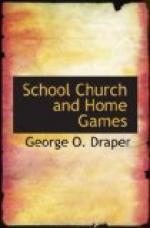New Orleans
The pupils of the room are divided into two groups. One side decides upon some action it will represent, such as sawing wood, washing clothes, etc., and thereupon represents the action. The other group has five chances to guess what the first group is trying to represent. Failing to do this, they must forfeit one of their players to the second group and the same side again represents an action.
When a group presents an action to the others, the following dialogue takes place:
First Group: Here we come.
Second Group: Where from?
First Group: New Orleans.
Second Group: What’s your trade?
First Group: Lemonade.
Second Group: How is it made?
The first group then represents the action.
Birds Fly
This is an attention game. The teacher stands before the class and instructs them that if she mentions some bird or object which flies and raises her arms sideward, imitating the flapping of the wings of a bird, the pupils are to follow her example. But if she mentions some animal or some object which does not fly, she may raise her arms sideward and upward, imitating the flying position, but the pupils are not to follow her example. If they are caught doing so, they must take their seats. For example,—the teacher says, “Owls fly”. Thereupon she and all the children raise their arms sideward and upward. She says, “Bats fly” and raises her arms. She next says, “Lions fly” and raises her arms, thereupon the pupils are supposed to keep their arms at their sides.
Music Rush
A march is played on the piano and the children march from their seats in single file around the room. As soon as the music stops, all rush to get into their seats. The last one in, must remain in his seat during the second trial. If there is no piano in the room, drumming on the top of a desk will do as well.
Change Seat Relay
The teacher claps her hands. This is the signal for all to shift one seat back. The one in the rear seat runs forward and sits in the front seat. The first aisle to become properly seated wins one point. Again the hands are clapped and the pupils shift one seat back, and the one then at the rear runs forward and takes the front seat and so the game continues until all have run forward from the back seat to the front. The aisle scoring the largest number of points wins.




